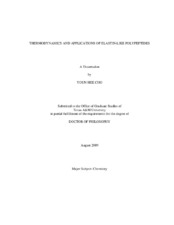| dc.description.abstract | Understanding protein stability and folding is of central importance in chemistry,
biology, and medicine. Despite its importance, a molecular level understanding of
protein stability still remains illusive due to the complexity of the system. In this study,
we employed protein-like polypeptides to study several aspects of protein stability in
different aqueous environments. The model system employed here is elastin-like
polypeptides (ELPs).
First, the modulation of the lower critical solution temperature (LCST) of neutral
ELPs was investigated in the presence of 11 sodium salts that span the Hofmeister series
for anions. It was found that the hydrophobic collapse/aggregation of these ELPs
generally followed the series. Specifically, kosmotropic anions decreased the LCST by
polarizing interfacial water molecules involved in hydrating amide groups on the ELPs.
By contrast, chaotropic anions lowered the LCST through a surface tension effect.
Additionally, chaotropic anions showed salting-in properties at low salt concentrations
that were related to the saturation binding of anions with the biopolymers. These overall
mechanistic effects were also compared to the results previously found for the
hydrophobic collapse and aggregation of poly(N-isoproplyacrylamide). A positively charged ELP, ELP KV6-112, was used as a next model system. We observed both
inverse and direct Hofmeister effects on LCST with five chaotropic salts.
Next, the solvent isotope effects on the LCST of ELPs were investigated as a
function of ELP chain length and guest residue chemistry using D2O and H2O.
Differences in the LCST values with heavy and light water were correlated with
secondary structure formation of the polypeptide chains which was quantified by circular
dichroism, FTIR, and differential scanning calorimetry measurements. It was found that
there is a great change in the LCST values between H2O and D2O for those polypeptides
which form the greatest amount of b-spiral structure. This study suggests that hydrogen
bonding rather than hydrophobicity is the key factor in the stabilization of ELPs in D2O
over H2O.
The phase transition property of ELPs can also be applied to development of
stimuli responsive biosensor system. In this study, we employed ELP-conjugate solid
supported lipid bilayer as a size selective binding sensor. | en |


